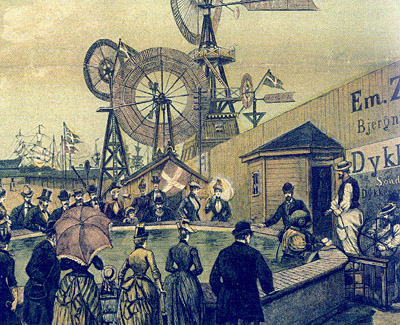| Drøm og virkelighed

| | Med det danske nederlag til Tyskland i 1864 blev skandinavismen sat tilbage, men i årene herefter kom der nye tiltag og en stadig voksende kulturel udveksling. Den første skandinaviske Kunst- og Industriudstilling fandt sted i København 1872.
Indenfor arkitekturen blev der udviklet fælles stiltræk og København blev centrum for det moderne gennembrud indenfor litteratur og kunst og tiltrak kunstnere fra hele Skandinavien. |
Skandinavismen – en fælles fiasko?
Skandinavismen var ikke noget færdigt politisk program, som man forsøgte at gennemføre. Skandinavisterne træffedes nu og da og efterhånden kom der nye idéer, sympatisører og symboler til. Det begyndte som en kulturel manifestation i de litterære kredse, udviklede sig til en virkelig fællesskabsfølelse med skåler og hurraråb i mængder blandt studenter og borgerskab og udviklede sig til en politisk enhedstanke, hvor ikke mindst kongerne havde vidtrækkende unionsplaner, som til sidst sønderlemmet af den europæiske storpolitiks virkelighed.
Man kan diskutere, hvor stærk den indbyrdes vilje og sammenhold egentlig var. Når og hvis man sammenligner med andre samtidige samlingsbestræbelser i Tyskland og Italien - som vel at mærke lykkedes - er det ikke fordi de politiske religiøse, kulturelle og sproglige forskelle var større - snarere tværtom. Et andet spørgsmål er omverdenen, i særdeleshed de europæiske stormagters holdning. Sikkert er det, at Rusland og for den sags skyld også Preussen ikke så med blide øjne på en samlet beherskelse af Øresund og hermed indsejlingen til Østersøen – med andre ord det klassiske problem i europæisk storpolitik vedrørende Øresunds- og Østersøregionen. Men ville de europæiske stormagter i givet fald have trodset folkets vilje i nationalliberalismes tidsalder?
Kunst- og industriudstillinger
På det økonomiske plan fik skandinavismen en vis gennemslagskraft, hvilket bl.a. manifesteres ved afholdelse af en skandinavisk Kunst- og Industriudstilling i København i 1872. Tanken om en fælles toldunion manes i jorden, men i 1873 skabes en skandinavisk møntunion med fælles værdi og fælles valutastrøm. Man behøvede altså ikke veksle penge indenfor Skandinavien og kursen var altid 100/100.
I 1888 afholdes atter kunst- og industriudstilling i Købehavn og fra 1889 stammer de første planer om en fast forbindelse over Øresund i form af en jernbanetunnel ved Helsingør – Helsingborg. Forslagsstilleren er en svensk ingeniør, Rudolf Lilljequist, som vil bringe ”Stockholm, Kristiania och Kjöbenhavn uti direkte järnvägsforbindelse med Hamburg, Berlin og Paris etc...” Det skulle blive det første af mange forslag til en fast forbindelse over Øresund.

Skandinavisk udstilling 1888 | 
Udstillingsbygning 1888 | 
Udstillingsbygningen | 
Fast forbindelse 1889 |
Monument for Slaget ved Lund
Den 4. december i året 1876 på 200årsdagen for slaget ved Lund startede en kreds af skandinavistisk indstillede en indsamling med henblik på opstilling af et mindesmærke på stedet hvor omkring 9.000 danske og svenske måtte lade livet i et blodigt indbyrdes opgør. Hensigten var vel at mærke ikke at fejre den knebne svenske sejr i slaget, men at skabe et fælles mindesmærke over begivenheden.
Monumentet blev tegnet af arkitekten Helgo Zetterwald og udført i den industrielle tidsalders materiale beton, som desværre forvitrer, således at en kopi i solid granit måtte opstilles i 1930. Indvielsen fandt sted ved en fælles dansk-svensk studenterfest i året 1883 og taler ved begivenheden var formanden for de skånske landskabers historiske og arkæologiske forening Martin Weibull.
Karakteristisk for denne begivenhed er nok dens forankring i det regionale, i de dansk-skånske relationer, som på forskellig vis tager et opsving omkring dette tidspunkt. Kredsen omkring Weibull og en række andre akademikere ved Lunds Universitet er ledende i disse bestræbelser, som tager sigte på at opdyrke den skånske kulturarv og historie. I så henseende kan man selvfølgelig ikke komme udenom de mange hundrede års fælles dansk-skånsk historie frem til 1658 og det giver sig også udslag på forskellig vis.

Monument for slaget ved Lund | 
Monument for slaget ved Lund |
|